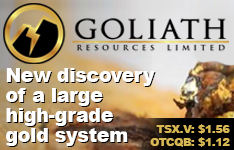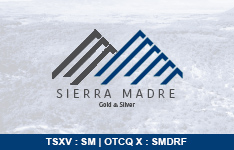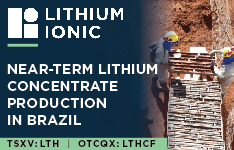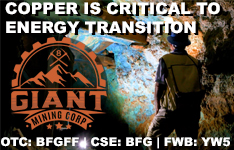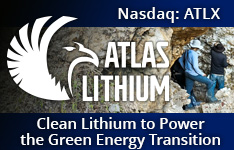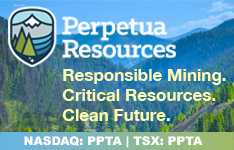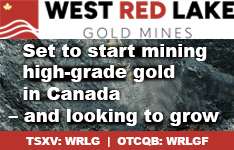Below is an interview by Rick Mills, the editor and publisher of Ahead of the Herd, with Bob Moriarty of 321 Gold.
Rick Mills (RM): I think current U.S. economic policies are steering us toward stagflation. U.S. Federal Reserve Chair Jerome Powell has publicly expressed concerns twice about diminishing growth alongside rising inflation. He essentially stated, paraphrasing here, "It's only a matter of time until Trump's tariffs stoke inflation, push up unemployment, and weaken economic growth." That's the definition of stagflation.
While our job market and economy remain resilient, so we're not experiencing stagflation yet, it's definitely a possibility on the horizon.
Traditional government currencies are weakening, and I believe you'll concur that commodities and precious metals remain the final secure investment option. Are we heading toward stagflation, which creates an ideal environment for commodities, gold, silver, and related stocks?
Bob Moriarty (BM): Without question. We're facing stagflation, and I'm glad to see everyday investors recognizing the benefits of precious metals. There are exceptional opportunities available now for those willing to take action.
RM: I completely agree and it's a crucial aspect of our message that we need to continue emphasizing. I understand you have several stocks you'd like to discuss.
You're favorable toward Pacific Empire Minerals Corp. (PEMC:TSX.V; PEMSF:OTCMKTS). What's your reasoning?
BM: The valuation makes sense. This perfectly illustrates what we've been discussing regarding market capitalization. Everyone dislikes this stock because they've been awaiting a drilling permit in central British Columbia. The BC administration has delayed issuing a permit, causing investors to abandon the stock in frustration.
The shares can be purchased today at just $0.015. If you compare current pricing to historical values, how recently was it trading at $0.03?
RM: I just examined the chart — very recently.
BM: It was $0.04 six weeks ago and $0.03 just a month ago. There's nothing fundamentally wrong with the company that can't be addressed.
Obviously, they'll need to secure financing before drilling, which won't happen until they receive a permit, but when you have a stock priced at $0.015, what actions could possibly make it more appealing?
RM: Tectonic Metals Inc. (TECT:TSX.V; TETOF:OTCQB; T15B:FSE), another company we've discussed, is conducting financing and implementing a share consolidation simultaneously to enhance appeal. It's definitely working.
BM: I've held TECT for years, and that's a perfect example of a proactive company with an excellent project making their stock more attractive through consolidation.
Nobody wants to touch PEMC at $0.015, so they should consolidate shares. The stock has already been devastated due to permit delays, so a 10:1 or 20:1 consolidation would create either a $0.15 or $0.30 stock. A $0.30 stock always appears more attractive than a $0.015 stock, even when the overall valuation remains identical.
In my 25 years discussing companies and stocks, I've seen many that could improve their appeal simply through consolidation. While I can't control when their permits will arrive, management absolutely needs to consolidate shares to attract investors.
Frankly, a $0.015 share price is embarrassing. Implement a 10:1 or 20:1 consolidation to establish a price investors will consider seriously, reduce outstanding shares, and eventually, the government will process their permit application.
The irony is that PEMC's website presentation showcases excellent projects in central BC, surrounded by major mines. This isn't a poor investment—it's a good one hindered by two factors: investors are frustrated by permit delays and the $0.015 share price. While they can't expedite the permit, they certainly can address the price through consolidation. This stock was worth $0.03 four weeks ago and $0.04 six weeks ago, so it's clearly worth significantly more than $0.015.
PEMC merits investment simply because it's undervalued. Eventually, a permit will arrive, and if management becomes proactive, they could implement a consolidation immediately to enhance appeal.
Let's briefly discuss Sitka Gold Corp. (SIG:TSXV; SITKF:OTCQB; 1RF:FSE), which just released results yesterday.
RM: Indeed, we previously discussed Sitka on April 8 when you described it as another Snowline Gold Corp. (SGD:TSX.V; SNWGF:OTCQB), then revised your assessment to say it's superior to Snowline. Now they've published news.
BM: Two things occurred — one predictable, the other infuriating.
The stock reached $0.62 on April 25. Before yesterday's announcement, it dropped $0.11 to $0.51. I've caught this pattern before, where someone anticipates positive results and purchases ahead of the announcement.
When you announce a drill core containing 138 samples with visible gold, everyone expects strong results, so many investors buy intending to sell immediately after the announcement — precisely what happened.
Two weeks ago, SIG traded at $0.62, declined 20% the day before results were published, then fell another 15% yesterday following the announcement.
Whenever discussions involve visible gold or claims of 50 meters of mineralization, everyone rushes to buy and sell immediately after the news breaks.
Regarding the project itself, it's undoubtedly exceptional. From a technical perspective, it resembles Snowline but in a superior location with better infrastructure.
RM: Sitka currently trades at $0.49. Some might view this as a buying opportunity.
You wanted to mention Altamira Gold Corp. (ALTA:TSX.V; EQTRF:OTCBB), a copper — gold venture in Brazil.
BM: This presents a fascinating situation, and interestingly, as I've often emphasized, sentiment matters greatly. The intriguing aspect is they recently announced an open — pit resource (the initial open — pit resource comprises total Indicated Resources of 24.19Mt @ 0.46g/t gold, totaling 357,800oz, and Total Inferred Resources of 25.64Mt @ 0.44g/t gold, totaling 362,400oz), yet the price only increased by $0.015.
What's amusing is they have this impressive project in a region that historically yielded millions of ounces through placer mining, with nine targets planned for exploration and five scheduled for drilling this year. They'll naturally need funding, so a capital raise is inevitable, but they doubled their resource and the stock gained merely 15% — it's truly remarkable.
RM: The market is completely unaware.
BM: The entire resource sector remains dormant, with only occasional activity emerging. This exemplifies something flying under the radar —economically viable gold in an excellent region within a stable country, yet completely overlooked.
RM: You've covered Pacific Empire, Altamira, and Sitka. Any additional topics?
BM: We're trying to highlight investment criteria, and there are two primary justifications for purchasing a stock: buy when it's inexpensive — determined by market capitalization, as with PEMC — or in situations like Altamira, where doubling resources should double the stock's value, though nobody has noticed yet, but they will.
RM: We initially discussed Harvest Gold Corp. (HVG:TSX.V) on April 8, and it's performed admirably. It still exemplifies what we've been discussing with its $2 million market cap and growth potential, which has materialized, plus they've announced additional news this week.
Vior management partnered with them, adding more claims. Vior represents the former Osisko Gold Royalties Ltd. (Now OR Royalties (OR:TSX; OR:NYSE) team following Gold Fields' acquisition — a powerful Quebec — based group that's raised hundreds of millions. When you consider them alongside Quinton Hennigh and Crescat Capital, it tremendously boosts confidence in Harvest Gold, especially with claim expansions continuing.
I appreciate Harvest Gold because I believe their project contains something worthwhile, particularly being situated on the Urban Barry Greenstone Belt within the Abitibi.
The stock appears to be progressing toward potentially becoming a premier exploration company in the significantly underexplored Urban Barry Greenstone Belt.
BM: I must disagree with your assessment.
RM: Go ahead.
BM: When we discussed this a month ago, what did I emphasize?
RM: Market capitalization.
BM: Exactly — the market cap doubled, so the stock doubled. How frequently do investments yield 100% returns within a month? Very rarely, yet people disregard this. They overcomplicate matters unnecessarily.
A month ago, it was so undervalued it practically screamed "buy me," but remarkably, at just $4.85M market cap currently, it remains absurdly undervalued.
The straightforward reason to buy anything is its affordability — it was inexpensive a month ago and remains so today.
RM: Recently, someone asked whether they should sell after such gains.
BM: How many reasons exist to purchase a stock?
RM: One — to generate profit.
BM: How many reasons exist to sell a stock?
RM: One — to secure profit.
BM: You buy to make money. Why do you sell?
RM: To deposit funds in your account.
BM: Pay taxes, purchase a vehicle, treat your spouse to dinner. Countless reasons exist to sell, but only one reason to buy.
So if you purchase at $3 and it reaches $6, is selling appropriate?
RM: Absolutely.
BM: Your objective is profitability. What's the only alternative to realizing gains?
RM: Losing money.
BM: Precisely. You either profit or lose on investments. I won't suggest selling any stock is incorrect, but taking profits is always beneficial.
It's unexpected income. But you need a strategy. I never criticize someone for securing profits.
RM: Each individual decides when to realize gains — it's their capital.
Another stock we mentioned just two weeks ago, Silver North Resources Ltd. (SNAG:TSX.V; TARSF: OTCQB), was at $0.11. They're experiencing significant market activity with strong volume, rising prices, and sufficient capital to drill a pure silver project in one of the world's premier mining regions — Yukon's Keno Hill silver district.
Their Haldane project neighbors Hecla's Keno Hill silver mine. I favor pure silver investments, and with the gold — to — silver ratio at 101.6, I believe this has staying power.
BM: Silver North has climbed from $0.10 to $0.165 — always favorable.
RM: I consider Kodiak Copper Corp. (KDK:TSX.V) undervalued and am examining its market capitalization.
With just 85 million shares outstanding @ $0.42, the market cap equals CA$36,000,000.
Kodiak's MPD project encompasses a vast land package within British Columbia's primary copper and gold — producing region.
The company will soon publish an initial resource estimate covering seven mineralized zones: Gate/Prime, Man, Dillard, Ketchan, West, Adit, and South/Mid.
Given positive copper market fundamentals and recent media attention, I anticipate a reevaluation of Kodiak's market cap based on: currently identified copper reserves; planned drilling on significant zone extensions beyond initial resource estimates; and numerous additional zones scheduled for drilling.
Kodiak Copper's MPD project demonstrates characteristics of a major copper/gold porphyry system potentially developing into a world — class mine. Their inaugural resource estimate arrives soon. The company has secured funding for extensive 2025 exploration/drilling programs, ensuring continuous news to maintain investor interest.
BM: While I'm unfamiliar with the company, I strongly support copper investments.
RM: I was reading Project Syndicate, one of my preferred subscription sites, featuring an article suggesting the Euro could strengthen based on Charles Kindleberger's hegemonic stability theory, which posits that an open, stable international system requires a dominant global power.
Britain served as the previous dominant power — the global financial and military leader during the 19th century.
The British pound functioned as the primary international currency, free trade flourished, the gold standard provided stability, the Bank of England acted as lender of last resort, and London's financial district appeared central to global finance. However, World War I weakened Britain, and by the 1930s, it lacked resources to support the international monetary system.
America was ascending while Britain declined, creating the Kindleberger Gap — the interval between dominant powers — which coincided with the Great Depression and political upheaval culminating in World War II.
The 1944 Bretton Woods conference marked the transition from Britain to America as the global hegemon, establishing the United States as the leader in trade, finance, and military strength.
Today, the U.S. dollar remains the world's reserve currency, Federal Reserve policies and American economic performance continue shaping global financial cycles, but we face a predicament where the current hegemon, the U.S., appears to be self — destructing or at minimum retreating from reserve currency responsibilities and global leadership.
BM: You've highlighted several critical points. First, history demonstrates that reserve currency status typically lasts approximately 80-82 years for any nation, which aligns precisely with our current position since 1944 — an interesting observation.
But did you catch Peter Schiff's recent comment regarding Jeff Gundlach? The Treasury Secretary [Scott Bessent] is discussing extending Treasury maturities and reducing interest rates on foreign — held Treasury securities. Let me explain why this matters: All debt eventually gets repaid — either by borrowers or by lenders.
The United States carries $37 trillion in funded obligations and exceeds $200 trillion in unfunded liabilities. Let me be absolutely clear: America is bankrupt. This isn't opinion — anyone performing basic calculations recognizes America's insolvency.
Despite Trump's rhetoric about reducing government expenses, he's actually increasing spending, expanding deficits, and growing total debt. When the Treasury Secretary discusses extending maturities and decreasing interest rates, he's essentially describing default.
Governments can address debt through three methods: taxation, inflation, or default.
While nobody openly discusses default, governments have employed this strategy for millennia. When the Treasury Secretary mentions defaulting on obligations, you can be certain we're approaching that reality. This will devastate the dollar's value. We've already witnessed approximately 20% fluctuation in dollar value against other currencies just within recent months.
RM: That's accurate. Would you be surprised if America becomes Trump's seventh bankruptcy?
BM: Well, credit where it's due. Everyone should excel at something — my only talent is flying beneath the Eiffel Tower — but Trump has mastered bankruptcy. Like adultery, he could author books on the subject. He's betrayed every spouse, deceived every contractor — the man has extensive experience.
RM: You're suggesting his expertise lies in bankruptcy.
BM: Bankruptcy and pursuing women with substantial assets.
RM: I reviewed information about the dollar and business conditions, and the Fed's Beige Book — essentially anecdotal economic activity reports — paints a grim picture of suspended business deals, decreasing demand, and increasing prices.
The first quarter saw 500,000 announced layoffs—the highest since early 2009 during the Great Recession's conclusion. Notably, over half of job eliminations occurred in Washington, reflecting DOGE federal government terminations.
The Fed maintained steady interest rates, citing growing economic uncertainty alongside a resilient job market as reasons for caution.
Here's a quote from Mark Dowding, chief investment officer at RBC's Bluebay Fixed Income team: "we had been long the dollar against the euro and closed that position over a week ago, it had lost impetus. The behavior of Trump has diminished appeal for U.S. assets in general."
Ray Dalio wrote: "Many are recognizing that whatever happens with tariffs these problems won't go away and the radically reduced interdependencies with the U.S. is a reality that has to be planned for."
That's remarkably direct language, Bob.
BM: I appreciate business leaders stepping forward saying, "Hold on, is this what we want?" But the tariff disaster hasn't even begun manifesting yet. Visit American stores two months from now — shelves will be empty. When that happens, unemployment will skyrocket.
RM: Steven Jen, chief executive and co — chief investment officer at Eurozone Capital, and his colleague published a MarketWatch report warning about potential sudden, disorderly dollar depreciation, comparing it to an avalanche. I'll summarize:
They suggest the avalanche moment may have arrived because Taiwan dollar and other Asian currency spikes could precede a more substantial dollar selloff. US trading partners might begin dumping their massive reserves of dollars and dollar — denominated assets accumulated since the pandemic. The vulnerable dollar holdings by China, Malaysia, Vietnam, and other major exporters exceed $2.5 trillion and have been increasing by approximately $500 billion annually.
That's an alarming sum potentially flooding the market, and domestic repatriation would create extreme inflation.
BM: Consider Japan's position. They hold approximately $1.2-1.3 trillion and have cautioned America that tariff impositions could trigger complete liquidation. Such action would instantly freeze bond markets and collapse the dollar.
When acting aggressively toward perceived enemies, anticipate unpleasant reciprocation. Trump behaves as though bullying tactics work universally, failing to recognize others possess significant leverage.
RM: An article earlier this week discussed countries redirecting trade. Canada suffered from tariffs, losing US trade with our principal partner, but within two months, we shifted 28% of former U.S. commerce to new markets while expanding existing ones.
Canada effectively recovered almost everything lost from U.S. trade within just two months.
These bilateral agreements, like those between Britain and India, potentially signal a new trade era.
Examining mergers and acquisitions, fewer deals are being finalized than during the worst periods of the COVID pandemic or 2008 global financial crisis.
M&A contract volume represents a crucial indicator of global economic health and has declined to the lowest level since February 2005.
Commercial mortgage — backed securities delinquency rates reached 10.3% in April, approaching record highs.
We're witnessing gradual collapse; an international drama unfolds regarding America, becoming increasingly concerning.
BM: Let me highlight part of the problem. I've previously stated everything from government and media contains falsehoods. I take this further than most — 100% of what you hear is false. I checked CNN an hour ago: "Trump in a major concession says the tariff on China should be 80%." How does reducing tariffs from 145% to 80% constitute a concession?
RM: It doesn't — it remains prohibitively high. But Trump's unexpected comment was "I'll leave it up to Bessent what the tariff is," already attempting to evade responsibility.
BM: Trump has crossed irreversible thresholds. His actions have catastrophically damaged the U.S. economy. We'll witness unemployment and inflation surge dramatically, and he'll bear responsibility.
These represent the most incredible developments I've observed, and regarding your opening comments about the Kindleberger Gap, I believe we're experiencing it. The dollar's decline will likely accelerate, unemployment will spike dramatically, inflation will soar, and beneath the surface — as we've discussed for six weeks — the global economy faces serious peril.
We're ignoring potential nuclear conflicts in Ukraine, Pakistan, and imminent war with Iran, possibly China, while active combat continues in Ukraine. Conditions are deteriorating, and Trump's actions worsen everything.
Since inauguration, Trump has made zero efforts to cultivate international relationships. He threatens universally and remarkably finally negotiated a tariff agreement with one nation, agreeing to reduce UK tariffs.
RM: I commented that the U.S. — UK trade agreement was completely insignificant.
BM: The UK represents merely 3% of American trade — an inconsequential partner. Average UK tariffs are 1%, so success would only reduce from 1% to zero. He still imposes 10% duties on UK goods, decreasing British demand for American products.
When you alienate everyone and maintain no allies, expect attacks from all directions. I observed Japanese and Taiwanese statements, noting Taiwan, Korea, and Japan have concluded that Treasury liquidation would cause them minor losses while inflicting catastrophic damage on America.
Within weeks, we'll witness unemployment surges in San Diego, Los Angeles, San Francisco, Seattle, and New York as trade represents such a crucial economic component. Trump displays incredible ignorance, stating "it's going to cost you more money for your dolls." Thanks for that insight, Donald.
RM: Seaport traffic is declining and will virtually cease within days, with warehouse inventories lasting five to seven weeks maximum, though most don't extend that far.
What's happening in Treasury markets — is the carry trade still relevant, or is something more sinister developing?
BM: Both statements are accurate. The carry trade collapses as foreign currencies strengthen, particularly the Japanese yen. Simultaneously, Japan and China are divesting Treasuries. Regarding your five-to-seven-week warehouse inventory observation: if warehouses contain five-to-seven weeks of retail goods, how quickly will store shelves empty?
RM: Within days.
BM: Precisely. Soon we'll witness consumer runs on Walmart, Kmart, Macy's, and others, with formerly affordable Chinese goods vanishing: no more iPads, iPhones, computers, jeans, or anything from Japan, Taiwan, China, Thailand, or Vietnam. Americans will discover rebuilding these supply channels requires considerable time.
Trump's actions harm all nations, but he fails to recognize America will suffer most severely.
RM: Canadians have recognized this consistently. With our 40 million population versus 340 million southward, we nonetheless exert disproportionate influence.
Trade significance isn't measured solely by monetary values but by what's supplied.
When you provide metals, potash, fertilizer, rare earths, energy — what you supply determines impact magnitude.
When President Trump dismisses Canadian importance, claiming independence from our resources, he underestimates the consequences of undermining supply chain foundations, which cascades through higher — value sectors.
I question whether they truly comprehend trade dynamics before pursuing this course.
I'm monitoring an upcoming China — U.S. trade meeting in Switzerland. Do you anticipate progress?
BM: Unlikely, primarily because Chinese officials understand tariff economics better than Americans. With 145% tariffs, trade volume becomes zero; reducing to 80% maintains zero trade. A 25% rate might facilitate discussion, but lowering from 145% to 80% remains meaningless.
The Chinese economy has suffered significantly, but America's economy has deteriorated more severely. Chinese actions regarding soybeans, rare earth elements, and magnets have devastated the American economy. We'll observe the negotiation outcomes. Both economies have suffered, but I believe America's situation exceeds China's difficulties.
RM: I concur because America lacks manufacturing infrastructure and established supply chains. We've consistently maintained that initiating trade conflicts with principal suppliers of unavailable goods seems foolhardy — equivalent to playing Russian roulette with a fully loaded revolver.
BM: Or using an automatic weapon.
RM: Charles Kindleberger's hegemonic stability theory states that open, stable international systems require dominant global leadership.
It appears our current global leader is retreating and rejecting responsibility, which carries numerous consequences.
Recent Gallup polling indicates only 16% of Americans now consider stocks the most profitable long — term investment. American investor attitudes are transforming.
What do you believe represents today's two most important American investments?
BM: Certainly gold, probably followed by cryptocurrencies.
RM: Investors have gained wisdom — real estate and gold lead preferences.
BM: Interestingly, real estate won't perform well. The sector is extremely overextended, as evident in Canada — real estate markets in the UK, Canada, and United States represent impending disasters.
RM: Great conversation, Bob, appreciate your insights.
You can view more from Rick and Bob at Ahead of the Herd and 321Gold.
BM: Thank you.
| Want to be the first to know about interesting Gold investment ideas? Sign up to receive the FREE Streetwise Reports' newsletter. | Subscribe |
Important Disclosures:
- Silver North Resources Ltd. is a billboard sponsor of Streetwise Reports and pays SWR a monthly sponsorship fee between US$4,000 and US$5,000.
- As of the date of this article, officers and/or employees of Streetwise Reports LLC (including members of their household) own securities of Silver North Resources Ltd., Tectonic Metals Inc., Snowline Gold Corp., and OR Royalties.
- Rick Mills: I, or members of my immediate household or family, own securities of: Harvest Gold and Tectonic Metlas. My company has a financial relationship with: Harvest Gold, Silver North Resources, and Kodiak Copper. I determined which companies would be included in this article based on my research and understanding of the sector.
- Bob Moriarty: I, or members of my immediate household or family, own securities of: Pacific Empire, Tectonic Metals, Sitka Gold, Altamira Gold, and Harvest Gold. My company has a financial relationship with: Altamira Gold Corp. and Harvest Gold Corp. I determined which companies would be included in this article based on my research and understanding of the sector.
- Statements and opinions expressed are the opinions of the author and not of Streetwise Reports, Street Smart, or their officers. The author is wholly responsible for the accuracy of the statements. Streetwise Reports was not paid by the author to publish or syndicate this article. Streetwise Reports requires contributing authors to disclose any shareholdings in, or economic relationships with, companies that they write about. Any disclosures from the author can be found below. Streetwise Reports relies upon the authors to accurately provide this information and Streetwise Reports has no means of verifying its accuracy.
- This article does not constitute investment advice and is not a solicitation for any investment. Streetwise Reports does not render general or specific investment advice and the information on Streetwise Reports should not be considered a recommendation to buy or sell any security. Each reader is encouraged to consult with his or her personal financial adviser and perform their own comprehensive investment research. By opening this page, each reader accepts and agrees to Streetwise Reports' terms of use and full legal disclaimer. Streetwise Reports does not endorse or recommend the business, products, services or securities of any company.
- This article does not constitute medical advice. Officers, employees and contributors to Streetwise Reports are not licensed medical professionals. Readers should always contact their healthcare professionals for medical advice.
For additional disclosures, please click here.
Ahead of the Herd Disclosures
Ahead of the Herd newsletter, aheadoftheherd.com, hereafter known as AOTH.
Please read the entire Disclaimer carefully before you use this website or read the newsletter. If you do not agree to all the AOTH/Richard Mills Disclaimer, do not access/read this website/newsletter/article, or any of its pages. By reading/using this AOTH/Richard Mills website/newsletter/article, and whether you actually read this Disclaimer, you are deemed to have accepted it.







